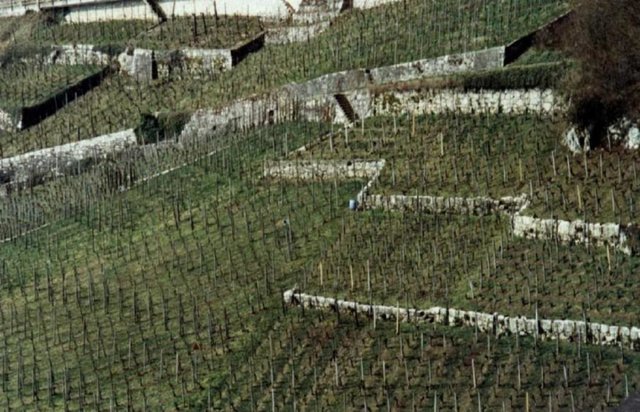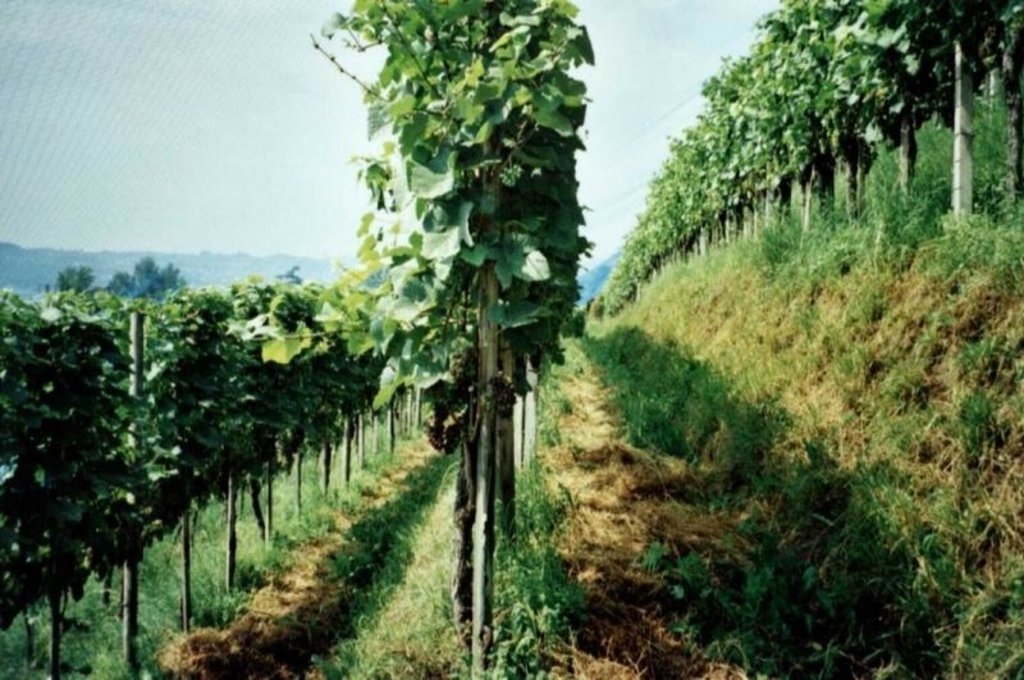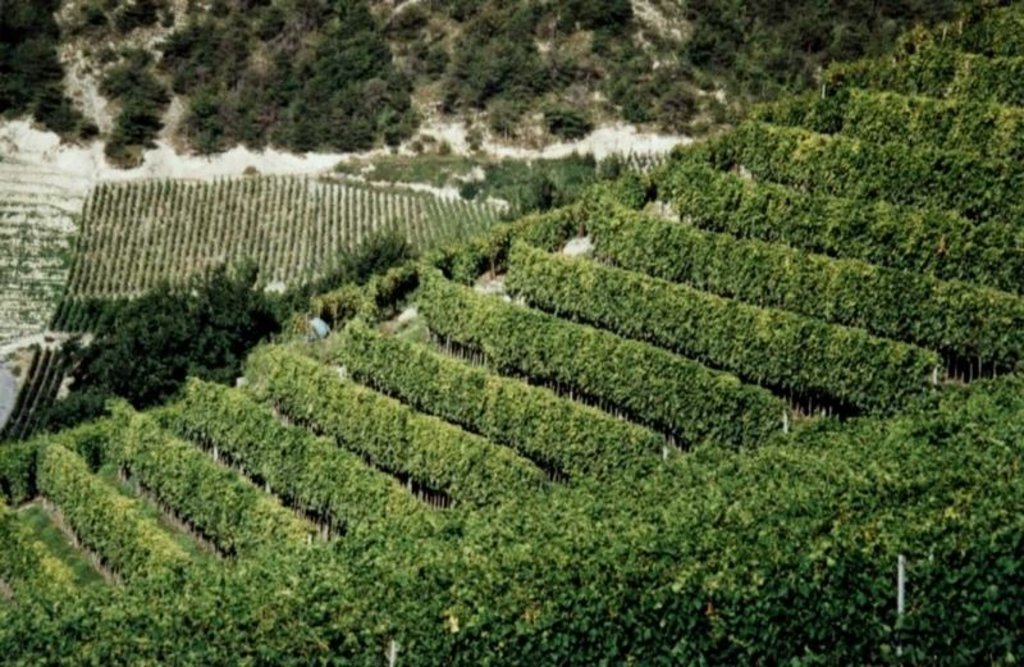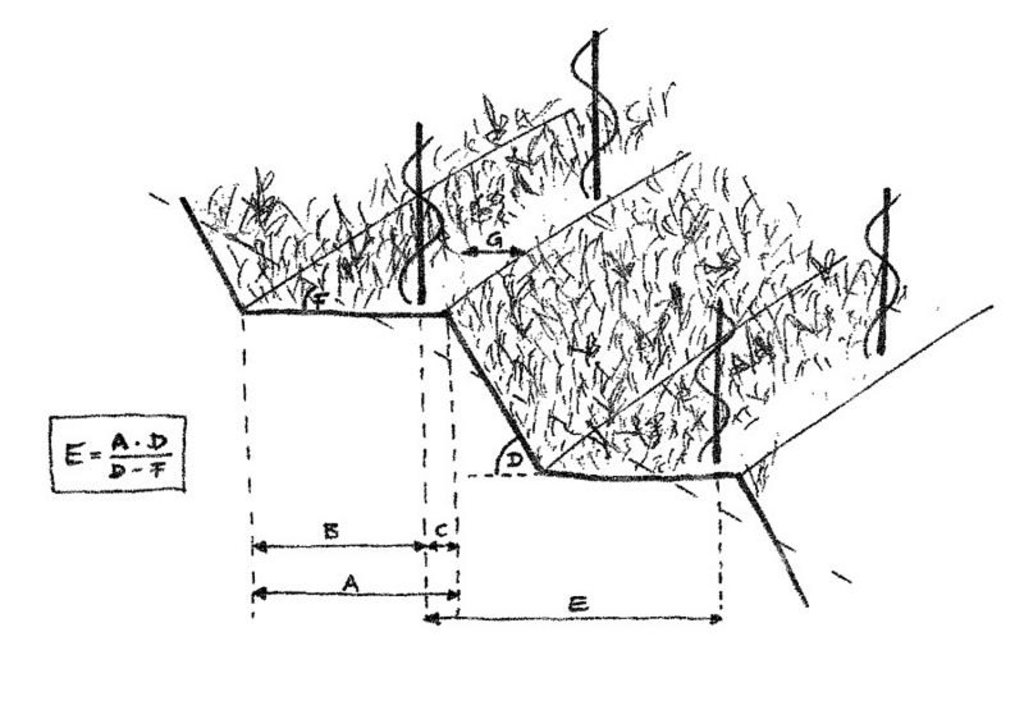Contour small bench terraces with permanent green cover in vineyards [Suíça]
- Criação:
- Atualização:
- Compilador/a: Nicole Guedel
- Editor: –
- Revisor: Fabian Ottiger
Ganzjährig begrünte Kleinterrassen im Rebbau
technologies_1011 - Suíça
Veja as seções
Expandir tudo Recolher tudo1. Informação geral
1.2 Detalhes do contato das pessoas capacitadas e instituições envolvidas na avaliação e documentação da tecnologia
Especialista em GST:
Weissenbach Peter
+41 (0)43 783 61 11
info@faw.admin.ch
Federal Research Station for fruit-growing, viticulture and horticulture-FAW
Postfach 185, 8820 Wädenswil, Switzerland
Suíça
Especialista em GST:
Spring Jean-Laurent
+41(0)22 363 44 44
info@rac.admin.ch
Federal Research Station for fruit-growing, viticulture and horticulture-RAC
CP 254 1260 Nyon 1, Switzerland
Suíça
usuário de terra:
Louis Hannes
+41 (32) 315 14 41
johannes.louis@schafiser.com
Louis Weinbau
Schafisweg 37a, 2514 Schafis, Switzerland
Suíça
usuário de terra:
Hasler Lukas
Hasler Weinbau
Moos 43, 2513 Twann, Switzerland
Suíça
Nome da(s) instituição(ões) que facilitou(ram) a documentação/ avaliação da Tecnologia (se relevante)
Federal Research Station for fruit-growing, viticulture and horticulture (FAW/RAC) - SuíçaNome da(s) instituição(ões) que facilitou(ram) a documentação/ avaliação da Tecnologia (se relevante)
CDE Centre for Development and Environment (CDE Centre for Development and Environment) - Suíça1.3 Condições em relação ao uso da informação documentada através de WOCAT
Quando os dados foram compilados (no campo)?
27/01/2004
O/a compilador/a e a(s) pessoa(s) capacitada(s) aceitam as condições relativas ao uso de dados documentados através da WOCAT:
Sim
1.5 Referência ao(s) questionário(s) sobre as abordagens da GST

Farmer initiative within enabling environment [Suíça]
Initiative and innovation of land users, stimulated by government's technical and financial support.
- Compilador/a: Nicole Guedel
2. Descrição da tecnologia de GST
2.1 Descrição curta da tecnologia
Definição da tecnologia:
Contour small bench terraces with stabilising permanent green cover in steep sloping vineyards.
2.2 Descrição detalhada da tecnologia
Descrição:
Description: The vineyards of the region are all, for micro-climatc reasons, more or less sloped. The technology is applied on steep to very steep slopes. It ist characterised by two elements: 1) small bench terrace with one contour-oriented vine row per terrace and 2) an initially sown all-year green cover of the soil surface for stabilisation reasons (green cover is also used between vine rows which are oriented up and down the slope, eg not terraced, see SWI01).
Purpose: Main purpose of the terrace construction is a possible mechanisation on steep to very steep slopes. Direct purpose of the green cover is the stabilisation of the small terraces, indirect but important purpose is the prevention of soil degradation, especially soil erosion by water and - secondary - to protect soil surface from compactation when using mechanised equipment.
Establishment: The terraces are constructed by external specialists and heavy machinery (walking excavator, type "Menzi Muck") and are considered to serve for a whole life cycle of the vine (20-40 years). The green cover is sown since stabilisation is needed from the very beginning on. The duration of the establishment is 3 years. Because of insufficient root length of young vines agronomic and vegetative measures differ from the "normal" measures: For reasons of competition the space around the freshly planted vines is kept free from vegetation with a hoe.
Maintenance: the topsoil is ripped from time to time with fuel driven machine (spade machine tracked by tractor). Cover vegetation is either cut or chopped and serves as mulching . Herbicides are applied around the vines. Minimum tillage and cutting / mulching may additionally serve to mobilise nutrients and to increase organic matter content or to eliminate competition of cover vegetation.
Natural environment: the vineyards are mainly placed on mountain or hill slopes, below 600 m a.s.l., annual rainfall is around 1000 mm with at least one erosive storm per year. The geological underground is limy, locally layered by Molasse (type of conglomerate). Soil properties are strongly influenced by anthropogenic activities (viticulture). Main degradation problem without green cover is erosion by water.
Human environment / land use: the region has a strong wine growing tradition (several centuries), belongs to the important Swiss wine growing regions and is not very densly populated.
First experiments with green cover in Switzerland were done in the 70ies around Zürich on contour small bench terraces, in the region of the lake of Biel contour small bench terraces with green cover started to be implemented in the 80ies
2.3 Fotos da tecnologia
2.5 País/região/locais onde a tecnologia foi aplicada e que estão cobertos nesta avaliação
País:
Suíça
Região/Estado/Província:
Canton of Berne
Especificação adicional de localização:
Lake of Biel
Comentários:
The technology is applied in all winegrowing regions of Switzerland, but under different conditions.
2.6 Data da implementação
Caso o ano exato seja desconhecido, indique a data aproximada:
- menos de 10 anos atrás (recentemente)
2.7 Introdução da tecnologia
Especifique como a tecnologia foi introduzida:
- através de projetos/intervenções externas
Comentários (tipos de projeto, etc.):
The development of contour small bench terraces with green cover in vineyards was (also on the international level) essentially promoted and supported by the Federal Research Station for fruit-growing, viticulture and horticulture in Wädenswil (Canton of Zürich) and Changins (Canton of Vaud)
3. Classificação da tecnologia de GST
3.2 Tipo(s) atualizado(s) de uso da terra onde a tecnologia foi aplicada

Terra de cultivo
- Cultura de árvores e arbustos
Principais plantações (colheitas para venda e consumo próprio):
Major cash crop perennial tree/shrub cropping: Vine grape
Comentários:
Major land use problems (compiler’s opinion): The main problem was decreasing soil fertility, especially throug soil erosion by water with negative off-site effects like sand- /sediment deposition and contamination of groundwater by nutrients. It became a serious problem since the 60ies when the fact became visible that the traditional labour-intensive cultivation system, which was strongly dependent on external inputss, could no longer be sustained within an industrialised agriculture system.
Type of cropping system and major crops comments: a vine plantation is established for a period of 20-40 years (lifetime of a vine). Some farmers make one year of fallow between the destruction of the old and the establishment of a new plantation.
3.3 Mais informações sobre o uso da terra
Comentários:
Water supply: rainfed, mixed rainfed - irrigated
Número de estações de cultivo por ano:
- 1
Especifique:
Longest growing period in days: 210Longest growing period from month to month: Apr - Oct
3.4 Grupo de GST ao qual pertence a tecnologia
- Solo/cobertura vegetal melhorada
- Medidas de curva de nível
- Stabilisation of terraces
3.5 Difusão da tecnologia
Comentários:
The technology is applied in all winegrowing regions of Switzerland, but under different conditions. The technology described (SWI02) is based on a case study of one region
3.6 Medidas de GST contendo a tecnologia
3.7 Principais tipos de degradação da terra abordados pela tecnologia

Erosão do solo pela água
- Wt: Perda do solo superficial/erosão de superfície
- Wo: efeitos de degradação externa

Deteriorização química do solo
- Cn: declínio de fertilidade e teor reduzido de matéria orgânica (não causado pela erosão)
- Cp: poluição do solo

Deteriorização física do solo
- Pc: Compactação
- Pk: quebra e ressecamento
Comentários:
Main type of degradation addressed: Wt: loss of topsoil / surface erosion, Wo: offsite degradation effects
Secondary types of degradation addressed: Cn: fertility decline and reduced organic matter content, Cp: soil pollution, Pc: compaction, Pk: sealing and crusting
Main causes of degradation: other human induced causes (specify) (agricultural causes: fast changing basic conditions of viticulture in the last 100 years), education, access to knowledge and support services (lack of knowledge), fast changing basic conditions of viticulture (economy, laws)
3.8 Redução, prevenção ou recuperação da degradação do solo
Especifique o objetivo da tecnologia em relação a degradação da terra:
- Reduzir a degradação do solo
Comentários:
Main goals: mitigation / reduction of land degradation
4. Especificações técnicas, implementação de atividades, entradas e custos
4.1 Desenho técnico da tecnologia
4.2 Especificações técnicas/ explicações do desenho técnico
Technical drawing of small contour bench terraces with permanent green cover. A = width of terrace, B = tractor area, C = distance between vine plant and terrace edge, D = gradient of terrace riser, E = distance of vine rows, F = orignal slope, G = zone of application of herbicides (10-40 cm).
Date: June 2003
Technical knowledge required for field staff / advisors: high
Technical knowledge required for land users: moderate
Main technical functions: control of dispersed runoff: retain / trap, reduction of slope angle, reduction of slope length, improvement of ground cover
Secondary technical functions: control of raindrop splash, increase of surface roughness, increase in organic matter, increase of infiltration, increase / maintain water stored in soil, improvement of soil structure, increase in soil fertility
Mulching
Material/ species: cut or chopped cover vegetation
Remarks: dispersed over the whole surface; if possible cutting/chopping (alternating)
Agronomic measure: removing less vegetation cover
Material/ species: cut or chopped cover vegetation, vine leaves and cut branches
Remarks: between vine rows
Manure / compost / residues
Material/ species: compost
Remarks: only sporadically (every 5-10 year or less)
Mineral (inorganic) fertilizers
Material/ species: nitrogen
Quantity/ density: 0-50 kg/ha
Remarks: normally rather little nitrogen
Agronomic measure: mineral (inorganic) fertilizers
Material/ species: potassium
Quantity/ density: 0-20 kg/ha
Agronomic measure: mineral (inorganic) fertilizers
Material/ species: magnesium
Quantity/ density: 0-25 kg/ha
Agronomic measure: mineral (inorganic) fertilizers
Material/ species: phosphorus
Quantity/ density: 0-20 kg/ha
Breaking compacted subsoil
Remarks: only on terrace, if possible only every second row/terrace (alternating)
Scattered / dispersed
Vegetative material: G : grass
Grass species: different grass species, taraxacum, veronica, legumes, calystegia, geranium...
Terrace: bench level
Vertical interval between structures (m): 1.3 m
Spacing between structures (m): 2.5 m
Construction material (earth): only earth of parcel
Slope (which determines the spacing indicated above): 60%
Lateral gradient along the structure: 0%
Vegetation is used for stabilisation of structures.
4.4 Atividades de implantação
| Atividade | Tipo de medida | Periodicidade | |
|---|---|---|---|
| 1. | sowing cover vegetation on the terrace riser (for stabilisation) (nonrecurring) | Vegetativo | winter/spring, usually at the same time as a new plantation is established |
| 2. | letting grow natural cover vegetation on terrace (nonrecurring) | Vegetativo | winter/spring, usually at the same time as a new plantation is established |
| 3. | Removing vegetation around vines (diameter of vegetation-free zone: 10 - 40 cm) | Vegetativo | during season (Mai – October), 2 - 4 times, when necessary. |
| 4. | removing old vines | Estrutural | winter/spring |
| 5. | deep tillage | Estrutural | winter/spring |
| 6. | construction of terraces | Estrutural | winter/spring |
| 7. | support of construction of terraces | Estrutural | winter/spring |
4.5 Custos e entradas necessárias para a implantação
Comentários:
Duration of establishment phase: 36 month(s)
4.6 Atividades recorrentes/manutenção
| Atividade | Tipo de medida | Periodicidade/frequência | |
|---|---|---|---|
| 1. | cuting and not removing vine leaves and branches | Agronômico | winter / annual |
| 2. | fertilising (mineral or manure/compost) | Agronômico | April/May / annual |
| 3. | cutting / chopping and then mulcihng cover vegetation | Agronômico | during cropping season (first time April/May) / each row 2-4 times during cropping season |
| 4. | cuting and not removing vine leaves and branches | Agronômico | during cropping season / several times during cropping season |
| 5. | breaking compacted topsoil | Agronômico | April/May / each row every 4-8 years |
| 6. | application of herbicides (glyphosates) | Vegetativo | beginning of season (May), if necessary second time in Aug./Sept /once (if necessary twice) during s |
| 7. | putting back earth which war fallen from the terrace riser to the terrace | Estrutural | winter/spring/if necessary |
| 8. | slightly reshaping terraces | Estrutural | winter/spring/if necessary |
4.7 Custos e entradas necessárias pata a manutenção/atividades recorrentes (por ano)
Comentários:
Machinery/ tools: e.g.: walking excavator, hoe, mower with tracked vehicle or portable motor scythe, spading machine with tracked vehicle; knapsack sprayer or biocide t
4.8 Fatores mais importantes que afetam os custos
Descreva os fatores mais determinantes que afetam os custos:
(manual) labour
5. Ambiente natural e humano
5.1 Clima
Precipitação pluviométrica anual
- <250 mm
- 251-500 mm
- 501-750 mm
- 751-1.000 mm
- 1.001-1.500 mm
- 1.501-2.000 mm
- 2.001-3.000 mm
- 3.001-4.000 mm
- > 4.000 mm
Especificações/comentários sobre a pluviosidade:
Average: Biel: 1200 mm. Region of Bielersee: 1000 - 1200 mm. Neuchâtel: 930 mm.
Zona agroclimática
- Subúmido
Thermal climate class: temperate
5.2 Topografia
Declividade média:
- Plano (0-2%)
- Suave ondulado (3-5%)
- Ondulado (6-10%)
- Moderadamente ondulado (11-15%)
- Forte ondulado (16-30%)
- Montanhoso (31-60%)
- Escarpado (>60%)
Formas de relevo:
- Planalto/planície
- Cumes
- Encosta de serra
- Encosta de morro
- Sopés
- Fundos de vale
Zona de altitude:
- 0-100 m s.n.m.
- 101-500 m s.n.m.
- 501-1.000 m s.n.m.
- 1.001-1.500 m s.n.m.
- 1.501-2.000 m s.n.m.
- 2.001-2.500 m s.n.m.
- 2.501-3.000 m s.n.m.
- 3.001-4.000 m s.n.m.
- > 4.000 m s.n.m.
Comentários e outras especificações sobre a topografia:
Altitudinal zone: 501-1000 m a.s.l. (For climatic reasons vines grow hardly above 600 m a.s.l. in Switzerland)
Landforms: Hill slopes (most of them southeastward sloping hills (part of the Jura mountain range))
Slopes on average: Steep (31-60%) (Vines are planted on different slopes. But contour small bench terraces are applied at steep slopes)
5.3 Solos
Profundidade do solo em média:
- Muito raso (0-20 cm)
- Raso (21-50 cm)
- Moderadamente profundo (51-80 cm)
- Profundo (81-120 cm)
- Muito profundo (>120 cm)
Textura do solo (solo superficial):
- Médio (limoso, siltoso)
Matéria orgânica do solo superficial:
- Médio (1-3%)
Caso disponível anexe a descrição completa do solo ou especifique as informações disponíveis, p. ex. tipo de solo, PH/acidez do solo, nitrogênio, capacidade de troca catiônica, salinidade, etc.
Soil depth: From shallow to very deep (Soil depth is very irregular, at some places limestone rocks appear at the surface, at other places soil can be quite deep.But if soil is very shallow for the whole parcel contour small bench terraces)
Soil fertilits is medium (Vines are normally grown on rather marginal spots. Compared to the general productivity these soils have a medium fertility. (If measured at the vine itself, soil fertility is sufficient/high))
Topsoil organic matter is medium (loamy,silty) (without / before SWC (green cover))
Soil drainage/infiltration is mostly good, at some spots medium (depressions; when high percentage of clay)
Soil water storage capacity is medium (without / before SWC (green cover)), high (without / before SWC (green cover)) or low (without / before SWC (green cover). Depressions; when high percentage of clay)
5.6 Características dos usuários da terra que utilizam a tecnologia
Orientação de mercado do sistema de produção:
- Comercial/mercado
Rendimento não agrícola:
- Menos de 10% de toda renda
Nível relativo de riqueza:
- Média
Nível de mecanização:
- Trabalho manual
- Mecanizado/motorizado
Indique outras características relevantes dos usuários da terra:
Population density: 200-500 persons/km2
Annual population growth: 0.5% - 1%
Off-farm income specification: This is representative for the full time winegrowers. The majority of winegrowers do winegrowing beside a regular off-farm job as a hobby. Nearly all winegrowers have implementeted the SWC technology. Probably there is no difference in hobby-winegrowers and full-time-winegrowers concernring implementation of the SWC technology.
Level of mechanization: Manual labour (most of the work in the vineyard is done by hand (especially harvest)) or mechanised (some of the activities are carried out with fuel driven equipment. But mechanisation is moderate since big and heavy machines cannot been applied in these vineyards).
Market orientation is commercial/market (in the region of the lake of Biel the majority of grapes are pressed to wine an then and sold directly from the farm's wine cellar)
5.7 Média da área de terra própria ou arrendada por usuários da terra que utilizam a tecnologia
- < 0,5 ha
- 0,5-1 ha
- 1-2 ha
- 2-5 ha
- 5-15 ha
- 15-50 ha
- 50-100 ha
- 100-500 ha
- 500-1.000 ha
- 1.000-10.000 ha
- > 10.000 ha
Comentários:
Average area of land owned or leased by land users applying the Technology: 0.5-1 ha, 1-2 ha, 2-5 ha, 5-15 ha (only winegrowing land!)
5.8 Propriedade de terra, direitos de uso da terra e de uso da água
Propriedade da terra:
- Indivíduo, intitulado
Direitos do uso da terra:
- Indivíduo
6. Impactos e declarações finais
6.1 Impactos no local mostrados pela tecnologia
Impactos socioeconômicos
Produção
Produção agrícola
Comentários/especificar:
maximum production capacity is reduced due to 1. Plantation density is smaller and 2. Capacity per vine is reduced due to slight competition of water and nutrients, intensified in the terrace riser under dry conditions
Qualidade da safra
Comentários/especificar:
Reduced quality of wine occurs when strong competition of water and nutrients happen and nothing is done against it.
Risco de falha de produção
Comentários/especificar:
Higher susceptibility to fungal decay due to higher evapotranspiration rate with green cover and therefore humid microclimatic conditions. Other problems are competition over water and nutrients or danger of frost - negligible - only in depressions or plains (due to higher evapotranspiration rate)
Renda e custos
Rendimento agrícola
Comentários/especificar:
Primarily due to less costs, especially resulting from less erosion damages in the long term (because of green cover). Secondary due to marketing argument "ecological agricultural production", subsidies related to green cover (direct payment which is only
Carga de trabalho
Comentários/especificar:
More and specific knowledge necessary
Outros impactos socioeconômicos
Inputs for mechanisation
Comentários/especificar:
Special machines needed, mechanisation is almost a must to be economically successful in the long term
Impactos socioculturais
Estado de saúde
Comentários/especificar:
Healthier than without SWC, less application of biocides and more comfortable and healty posture of body.
Instituições comunitárias
Comentários/especificar:
Increased exchange of knowledge and contacts in winegrowers society
Instituições nacionais
Comentários/especificar:
Research stations gained new knowledge and attention
Conhecimento de GST/ degradação da terra
Comentários/especificar:
Among winegrowers, but perhaps also slightly among consumers (through an ecological marketing argument) or walkers (walking through a green vineyard may arise interest in green cover).
Atenuação de conflitos
Comentários/especificar:
Between generations or between farmers applying green cover and others. Reason: farmers are differently attached to traditional values and norms (i.e.: traditionally every plant was seen as unuseful weed and fought with a hoe).
Personal satisfaction / challenge
Comentários/especificar:
Many farmers apply green cover see green cover as a personal satisfaction or challenge for an ecologically and economically sustainable viticulture
Acceptance by society
Comentários/especificar:
Landscape and appearance of Landscape & appearance of vineyard as cultural heritage. Different values an norms of "how a vineyard should look like". Traditionally vines were planted very dense with no vegetation cover in between. Contour small bench terraces are quite new to the area (20-30 years)
Impactos ecológicos
Solo
Umidade do solo
Comentários/especificar:
Especially through improved water retention capacity (due to improved soil structure)
Cobertura do solo
Perda de solo
Comentários/especificar:
Mainly due to green cover (rather than terraces)
Compactação do solo
Biodiversidade: vegetação, animais
Espécies exóticas invasoras
Comentários/especificar:
Undesirable plant and animal species (i.e. mice (can hamper stability of terrace riser and terrace itself))
Controle de praga/doença
Comentários/especificar:
Through beneficial animals
Clima e redução de riscos de desastre
Velocidade do vento
Outros impactos ecológicos
Biodiversity
Comentários/especificar:
High diversity due to different habitats (extensively managed terrace riser and terrace)
Soil fertility
6.2 Impactos externos mostrados pela tecnologia
Cheias de jusante
Sedimentação a jusante
Poluição de água subterrânea/rio
Sedimentos transportados pelo vento
6.4 Análise do custo-benefício
Como os benefícios se comparam aos custos de implantação (do ponto de vista dos usuários da terra)?
Retornos a curto prazo:
muito negativo
Retornos a longo prazo:
neutro/balanceado
Como os benefícios se comparam aos custos recorrentes/de manutenção(do ponto de vista dos usuários da terra)?
Retornos a curto prazo:
levemente negativo
Retornos a longo prazo:
neutro/balanceado
6.5 Adoção da tecnologia
Entre todos aqueles que adotaram a tecnologia, quantos adotaram espontaneamente, ou seja, sem receber nenhum incentivo material/pagamentos?
- 90-100%
Comentários:
10% of land user families have adopted the Technology with external material support
Comments on acceptance with external material support: estimates
90% of land user families have adopted the Technology without any external material support
Comments on spontaneous adoption: estimates
There is a strong trend towards spontaneous adoption of the Technology
Comments on adoption trend: Contour small bench terraces with green cover are seen as good opportunity for viticulture in steep slopes. Adoption is done mainly spontaneous
Links e módulos
Expandir tudo Recolher tudoLinks

Farmer initiative within enabling environment [Suíça]
Initiative and innovation of land users, stimulated by government's technical and financial support.
- Compilador/a: Nicole Guedel
Módulos
Não há módulos





